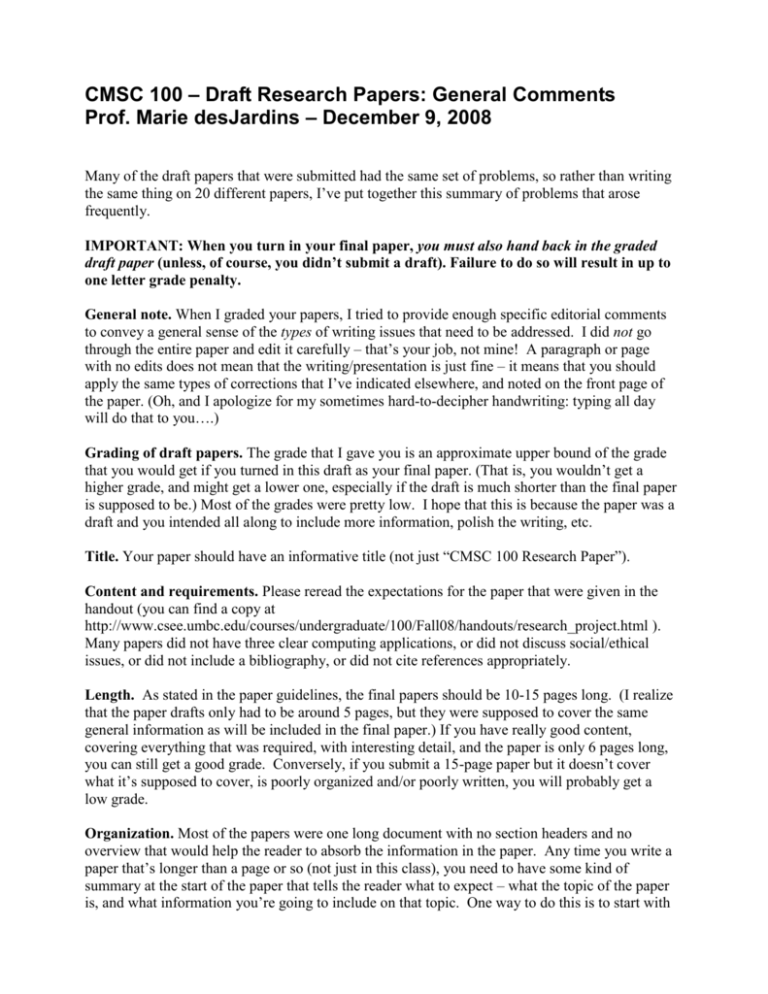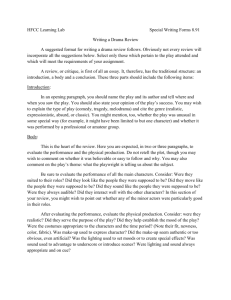CMSC 100 – Draft Research Papers: General Comments
advertisement

CMSC 100 – Draft Research Papers: General Comments Prof. Marie desJardins – December 9, 2008 Many of the draft papers that were submitted had the same set of problems, so rather than writing the same thing on 20 different papers, I’ve put together this summary of problems that arose frequently. IMPORTANT: When you turn in your final paper, you must also hand back in the graded draft paper (unless, of course, you didn’t submit a draft). Failure to do so will result in up to one letter grade penalty. General note. When I graded your papers, I tried to provide enough specific editorial comments to convey a general sense of the types of writing issues that need to be addressed. I did not go through the entire paper and edit it carefully – that’s your job, not mine! A paragraph or page with no edits does not mean that the writing/presentation is just fine – it means that you should apply the same types of corrections that I’ve indicated elsewhere, and noted on the front page of the paper. (Oh, and I apologize for my sometimes hard-to-decipher handwriting: typing all day will do that to you….) Grading of draft papers. The grade that I gave you is an approximate upper bound of the grade that you would get if you turned in this draft as your final paper. (That is, you wouldn’t get a higher grade, and might get a lower one, especially if the draft is much shorter than the final paper is supposed to be.) Most of the grades were pretty low. I hope that this is because the paper was a draft and you intended all along to include more information, polish the writing, etc. Title. Your paper should have an informative title (not just “CMSC 100 Research Paper”). Content and requirements. Please reread the expectations for the paper that were given in the handout (you can find a copy at http://www.csee.umbc.edu/courses/undergraduate/100/Fall08/handouts/research_project.html ). Many papers did not have three clear computing applications, or did not discuss social/ethical issues, or did not include a bibliography, or did not cite references appropriately. Length. As stated in the paper guidelines, the final papers should be 10-15 pages long. (I realize that the paper drafts only had to be around 5 pages, but they were supposed to cover the same general information as will be included in the final paper.) If you have really good content, covering everything that was required, with interesting detail, and the paper is only 6 pages long, you can still get a good grade. Conversely, if you submit a 15-page paper but it doesn’t cover what it’s supposed to cover, is poorly organized and/or poorly written, you will probably get a low grade. Organization. Most of the papers were one long document with no section headers and no overview that would help the reader to absorb the information in the paper. Any time you write a paper that’s longer than a page or so (not just in this class), you need to have some kind of summary at the start of the paper that tells the reader what to expect – what the topic of the paper is, and what information you’re going to include on that topic. One way to do this is to start with a paragraph that introduces the paper as a whole and your general topic, then have a paragraph that summarizes the information in the paper. After that, you might have (for this paper) six subsections: one describing your application domain in some detail; then three subsections, one for each of the three computing techniques you’ll talk about; then a section on social impact/ethics; and finally a conclusion, with the references at the end of the paper. Please use section headers to indicate these subsections explicitly. Simple boldface titles at the start of paragraphs, as I’ve included in these guidelines, are enough to provide some “guideposts” for the reader. Writing style. In general, the writing that I saw was much too informal for a research paper. This was not a creative writing assignment or an opinion essay. While it doesn’t have to be as formal and structured as a published research paper would be, it should be factual and to the point, not anecdotal and casual. Some specific writing issues that I noted repeatedly: Don’t talk about your paper or your decision to write the paper – just deliver the information. So phrases like “This paper will discuss…” or “I picked this topic because…” should not appear in the paper. Avoid colloquial language (“lots of,” “really great,” “messed up,” “tweaking”), including “opinion-based” qualifiers (“incredibly,” “amazingly,” and usually “very”), contractions, and extensive use of personal anecdote or “illustrative” scenarios. The paper should have a logical structure as a whole. (The suggestions about organization, above, are a starting point.) Within each section, each paragraph should have a purpose, and they should be ordered in a logical way. Within each paragraph, each sentence should have a purpose, and they should be ordered in a logical way. Avoid repetition and “fluff” filler sentences that convey no meaningful information. (Yes, this will get your paper closer to the target length, but it will also reduce the quality of what’s there – and you’ll get a higher grade with a well written, to-the-point, 5-page paper than with a repetitive 10-page paper with little actual content.) I use certain abbreviations in marking up papers, so here’s a guideline to my cryptic annotations: o rep. – repetitive o gr. – grammatical error o colloq. – colloquial language o inf. – informal language (not quite as bad as colloquial but still too “unprofessional” in tone) o awk./phr. – awkward phrasing – not grammatically incorrect, but stilted or excessively wordy Bibliography and citations. Your paper should include a bibliography. The paper itself should demonstrate that you actually read and learned someething from the sources that you include. Citations to specific sources should be included for factual information in the paper – you don’t have to cite the same source repeatedly if you’re summarizing material from one place over the course of a paragraph or two; it only needs to be cited once when you first start talking about that system/topic. All bibliographic entries should be cited somewhere in the paper. Images. Many of the papers would benefit from some illustrations or images. You should feel free to include these, though they should augment (not replace) the content of the papers itself.








